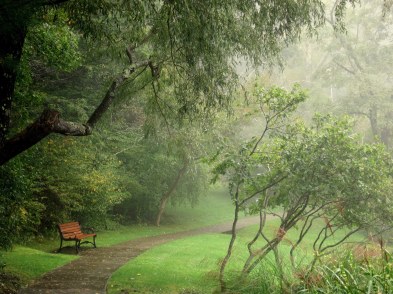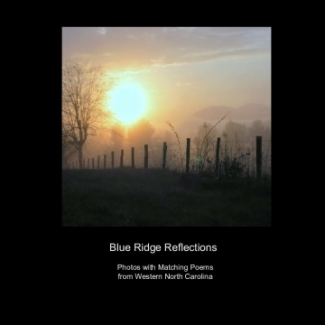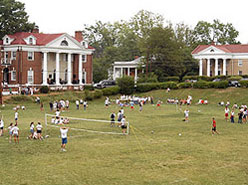When my wife Patricia Joynes sees a morning fog or the beginning of a crimson sunset, she abruptly leaves the house to submit to her passion. She is a nature photographer.
Years ago, when her 35 mm film cameras and her role as family event documentarian became obsolete, Pat turned her attention to nature photography with a small Canon Power Shot S110 digital camera. Her focus was on the Appalachian Mountains near our home around the Blue Ridge Parkway for its natural beauty aesthetics.

The Blowing Rock Attraction, Blowing Rock, NC
Her first published credits were in books and journals, but her Blue Ridge photographs became recognized in the Town of Blowing Rock, North Carolina annual calendars (2015, cover in 2016, and three pictures in 2017) and the annual Blue Ridge Parkway calendar (2017, 2018).

Pat also published annual family calendars of her nature photos with aphorisms by me in 2016 and 2017. By that date, the edited file of her Blue Ridge-centered photographs exceeded 10,000 images!

Mayview Park, Blowing Rock, NC
In early 2017, Pat asked me, a published poet, to write poems inspired by specific photographs. We were both amazed at the collaborative results as the first poems emerged. The titles give clues to the content: The Puddle Portal, The Sanctified Bridge, Split-Rail Fence, and Solitary Bench. Week after week, as Pat presented me with other photographs, I wrote matching poems. By mid-September I had completed 29 of them!

Mayview Park, Blowing Rock, NC
Here is a sample photo and poem from the book.

Become the First
Before there were human eyes to see
there were a millennia of dawns
and foggy mountain wooded sunsets
whose nascent glory went unreported.
From any high Blue Ridge vantage point
creation unfolds in waves of light,
and time is a cycle of the sun
that produces growth and the promise
of life in its regular passing.
What was it like to be the first to see
the distant waves of an evergreen sea?
What was the valley fog assumed to be?
And what monsters did they prepare to flee?
Primal emotions are felt in all ages
as the wild universe is explored.
A ravens’ rock becomes sacrosanct
in a landscape bereaved of doors.
Rejoice that the search for tomorrows
is still the possibility of today.
Become the first to reach the mountaintop
and see its natural wonders on display.



 It was a Sunday afternoon at a University of Virginia fraternity house located in a cluster of frat houses that overlooked an intramural field depression known as “Mad Bowl” when I met Bob Dylan and witnessed him rejected as a folk singer and song writer.
It was a Sunday afternoon at a University of Virginia fraternity house located in a cluster of frat houses that overlooked an intramural field depression known as “Mad Bowl” when I met Bob Dylan and witnessed him rejected as a folk singer and song writer. Clayton’s purpose on that Sunday afternoon was to have newcomer Bob Dylan and recorded folk singer Carolyn Hester sing a few songs as a measure of their live performance abilities. It was easy to pull the frat boys away from the ball game on television once they got an introduction to Carolyn Hester. She was 24 years old at the time and Hollywood gorgeous. Hester had already released two albums and was being compared to folk music star Joan Baez. Clayton was helping her with her live performance guitar playing, which was weak at the time. Hester stood against the living room wall and performed two unremembered songs. Her singing was strong and beautiful, but she missed some chords in the accompaniment.
Clayton’s purpose on that Sunday afternoon was to have newcomer Bob Dylan and recorded folk singer Carolyn Hester sing a few songs as a measure of their live performance abilities. It was easy to pull the frat boys away from the ball game on television once they got an introduction to Carolyn Hester. She was 24 years old at the time and Hollywood gorgeous. Hester had already released two albums and was being compared to folk music star Joan Baez. Clayton was helping her with her live performance guitar playing, which was weak at the time. Hester stood against the living room wall and performed two unremembered songs. Her singing was strong and beautiful, but she missed some chords in the accompaniment.
 invited Bob Dylan to play harmonica on sessions for her third album at Columbia Records. At a rehearsal session, Dylan met celebrated record producer John Hammond who signed him to a recording contract. Dylan’s first album on Columbia Records was released on March 19, 1962. The album made a great impression in the folk music community, but it was not commercially successful.
invited Bob Dylan to play harmonica on sessions for her third album at Columbia Records. At a rehearsal session, Dylan met celebrated record producer John Hammond who signed him to a recording contract. Dylan’s first album on Columbia Records was released on March 19, 1962. The album made a great impression in the folk music community, but it was not commercially successful.






